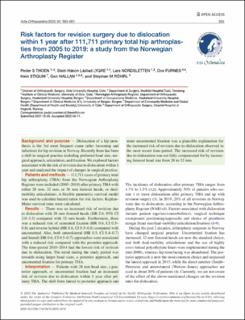| dc.contributor.author | Thoen, Peder Svenkerud | |
| dc.contributor.author | Lygre, Stein Håkon Låstad | |
| dc.contributor.author | Nordsletten, Lars | |
| dc.contributor.author | Furnes, Ove Nord | |
| dc.contributor.author | Stigum, Hein | |
| dc.contributor.author | Hallan, Geir | |
| dc.contributor.author | Röhrl, Stephan Maximillian | |
| dc.date.accessioned | 2022-09-20T13:54:11Z | |
| dc.date.available | 2022-09-20T13:54:11Z | |
| dc.date.created | 2022-07-25T10:07:43Z | |
| dc.date.issued | 2022 | |
| dc.identifier.issn | 1745-3674 | |
| dc.identifier.uri | https://hdl.handle.net/11250/3019245 | |
| dc.description.abstract | Background and purpose: Dislocation of a hip prosthesis is the 3rd most frequent cause (after loosening and infection) for hip revision in Norway. Recently there has been a shift in surgical practice including preferred head size, surgical approach, articulation, and fixation. We explored factors associated with the risk of revision due to dislocation within 1 year and analyzed the impact of changes in surgical practice. Patients and methods: 111,711 cases of primary total hip arthroplasty (THA) from the Norwegian Arthroplasty Register were included (2005-2019) after primary THA with either 28 mm, 32 mm, or 36 mm femoral heads, or dualmobility articulations. A flexible parametric survival model was used to calculate hazard ratios for risk factors. Kaplan-Meier survival rates were calculated. Results: There was an increased risk of revision due to dislocation with 28 mm femoral heads (HR 2.6, 95% CI 2.0-3.3) compared with 32 mm heads. Furthermore, there was a reduced risk of cemented fixation (HR 0.6, CI 0.5-0.8) and reverse hybrid (HR 0.6, CI 0.5-0.8) compared with uncemented. Also, both anterolateral (HR 0.5, CI 0.4-0.7) and lateral (HR 0.6, CI 0.5-0.7) approaches were associated with a reduced risk compared with the posterior approach. The time-period 2010-2014 had the lowest risk of revision due to dislocation. The trend during the study period was towards using larger head sizes, a posterior approach, and uncemented fixation for primary THA. Interpretation: Patients with 28 mm head size, a posterior approach, or uncemented fixation had an increased risk of revision due to dislocation within 1 year after primary THA. The shift from lateral to posterior approach and more uncemented fixation was a plausible explanation for the increased risk of revision due to dislocation observed in the most recent time-period. The increased risk of revision due to dislocation was not fully compensated for by increasing femoral head size from 28 to 32 mm. | en_US |
| dc.language.iso | eng | en_US |
| dc.publisher | Medical Journals Sweden | en_US |
| dc.relation.uri | https://actaorthop.org/actao/article/view/3474 | |
| dc.rights | Navngivelse-Ikkekommersiell 4.0 Internasjonal | * |
| dc.rights.uri | http://creativecommons.org/licenses/by-nc/4.0/deed.no | * |
| dc.title | Risk factors for revision surgery due to dislocation within 1 year after 111,711 primary total hip arthroplasties from 2005 to 2019: a study from the Norwegian Arthroplasty Register | en_US |
| dc.type | Journal article | en_US |
| dc.type | Peer reviewed | en_US |
| dc.description.version | publishedVersion | en_US |
| dc.rights.holder | Copyright 2022 the authors | en_US |
| cristin.ispublished | true | |
| cristin.fulltext | original | |
| cristin.qualitycode | 1 | |
| dc.identifier.doi | 10.2340/17453674.2022.3474 | |
| dc.identifier.cristin | 2039286 | |
| dc.source.journal | Acta Orthopaedica | en_US |
| dc.source.pagenumber | 593-601 | en_US |
| dc.identifier.citation | Acta Orthopaedica. 2022, 93, 593-601. | en_US |
| dc.source.volume | 93 | en_US |

